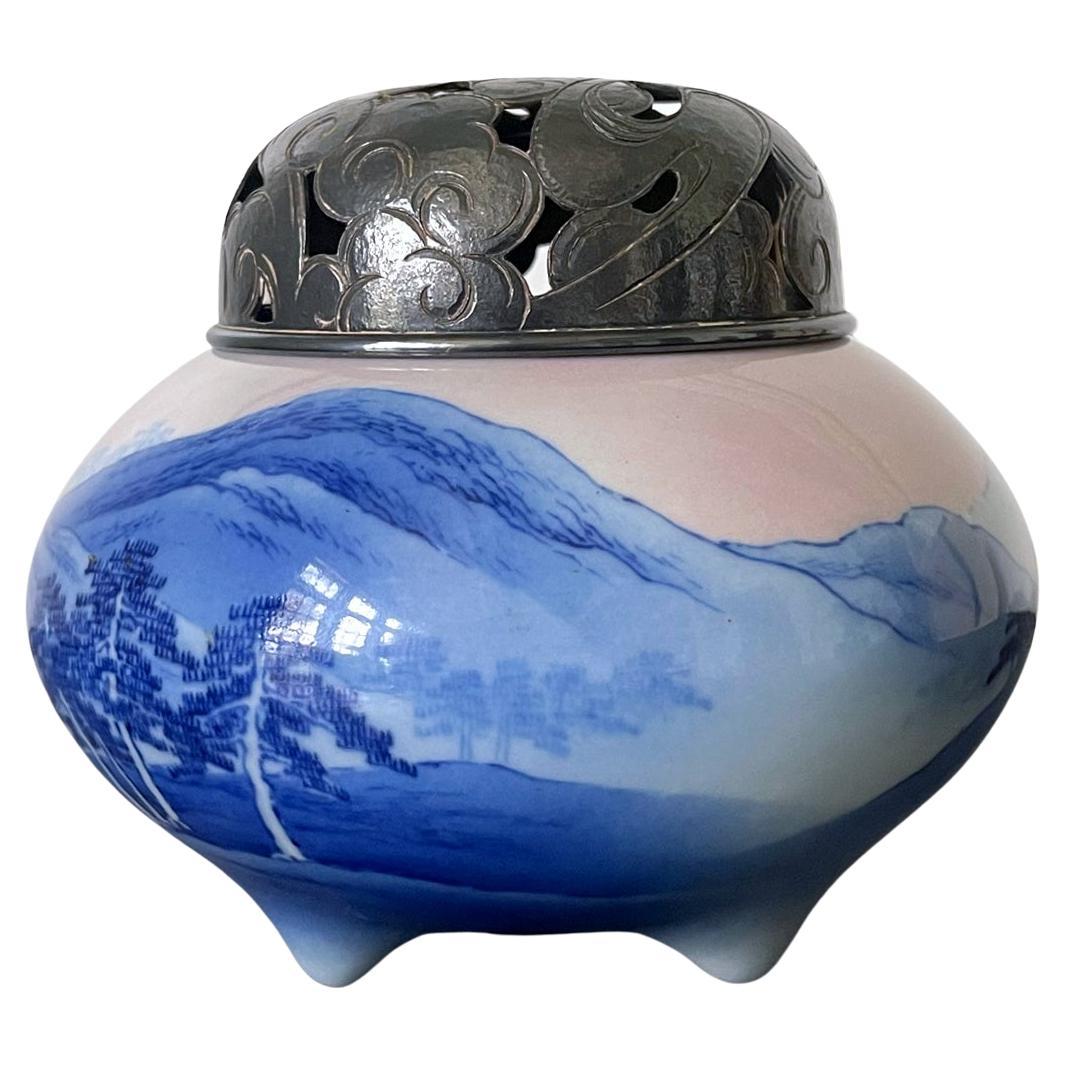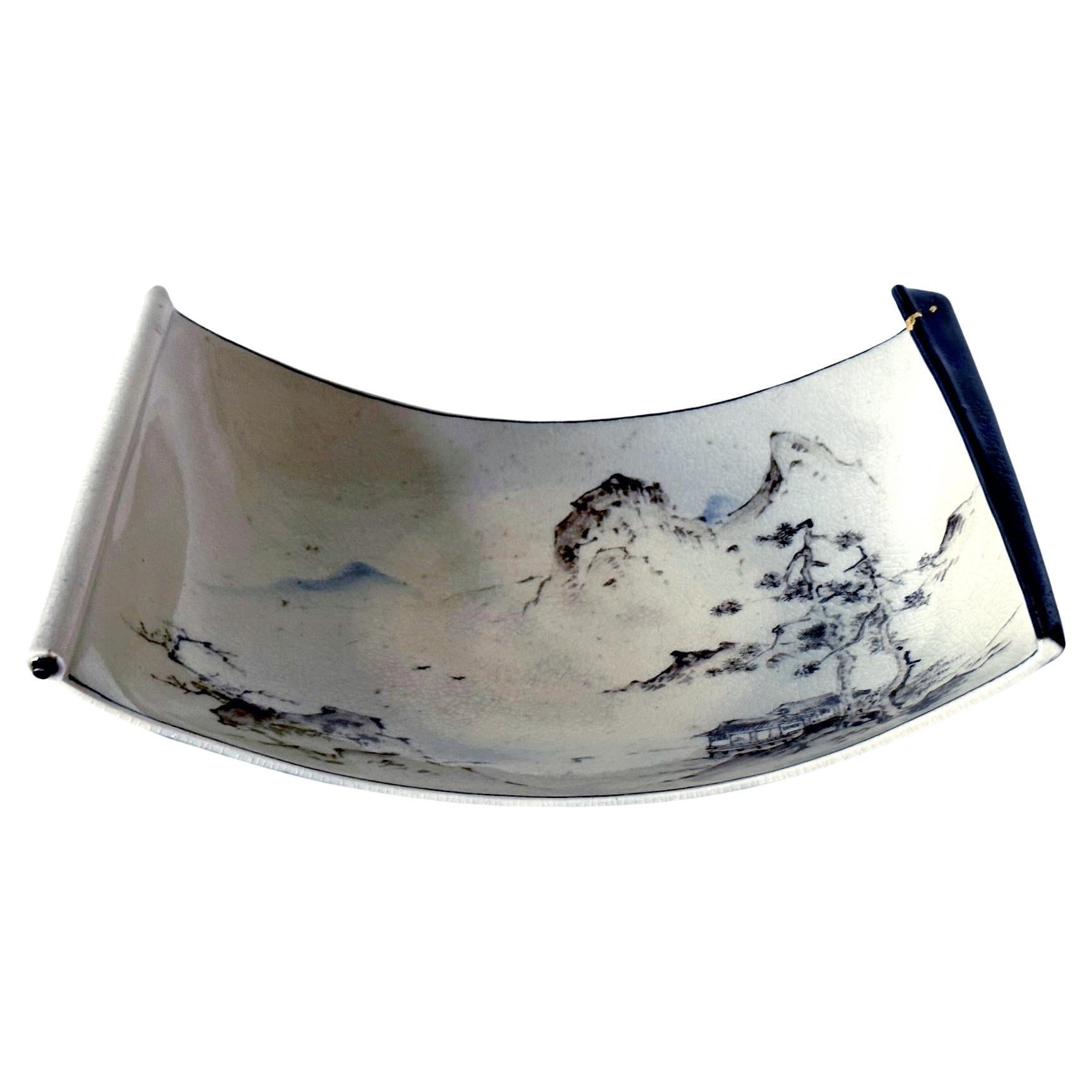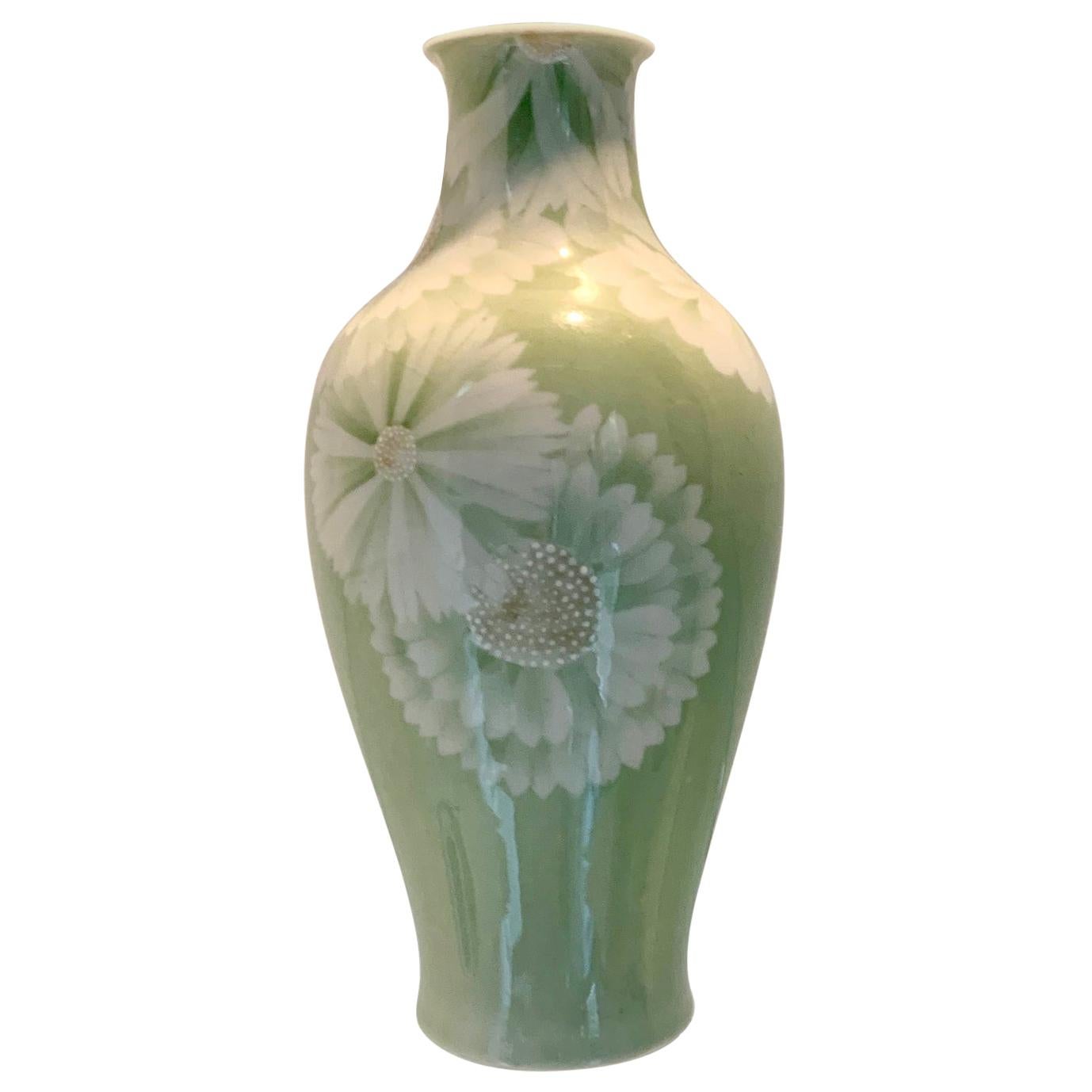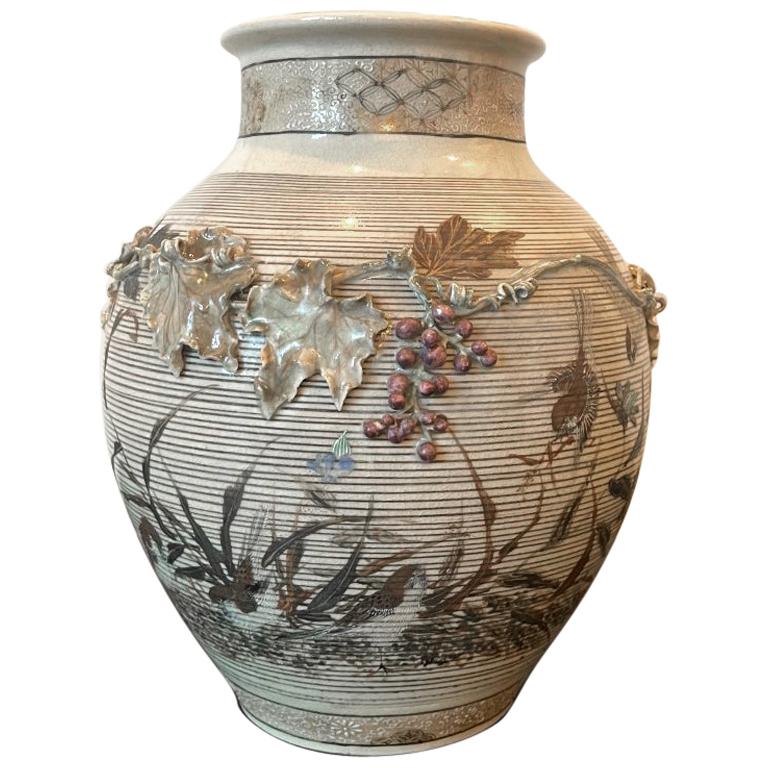Items Similar to Rare Japanese Porcelain Incense Burner with Inlays Makuzu Kozan
Want more images or videos?
Request additional images or videos from the seller
1 of 21
Rare Japanese Porcelain Incense Burner with Inlays Makuzu Kozan
About the Item
A porcelain incense burner (koro) made by Japanese potter Makuzu Kozan (also known as Miyagawa Kozan, 1842-1916) circa 1890s-1900s (end of Meiji Period). The koro features an elegant shape with a compressed rounded body supported by three long "deer" legs slightly curving outwardly. The lid features a top knob delicately molded in the shape of a cluster of stemmed Lingzi (longevity mushroom). The koro is completely glazed in light celadon color except for the base which bears the pressed mark of two Kanji characters in archaic font "Makuzu". Low relief white slip inlays decorate the four facades in alternate motifs of Pheonix in flight and clusters of chrysanthemum flowers and paulownia leaves. Round circles circumvent the upper and lower border of the body as well as the edge of the lid. The exterior side of each leg also showcases an inlay of a Lingzi mushroom branch. The decoration of this koro was done in the style of Caledon porcelain from Goryoe dynasty (10th to 14th century) in Korea, which is considered the zenith of such technique in porcelain production.
An old paper label remains on the bottom of the interior, on which it reads the item number, artist's name (Miyagawa Kozan), title (White Goryeo Deer) and historical price tag.
The Goryeo Caledon-inspired piece like this is rare among Makuzu Kozan's existing pieces. There is one such known piece (also a koro) with near identical decoration technique and motif in publication. It belonged to the collection of the last Meiji emperor as illustrated in last two photos of the listing.
- Creator:Makuzu Kozan (Artist)
- Dimensions:Height: 5.5 in (13.97 cm)Diameter: 6 in (15.24 cm)
- Style:Meiji (Of the Period)
- Materials and Techniques:
- Place of Origin:
- Period:
- Date of Manufacture:1890-1910s
- Condition:Wear consistent with age and use. Fine antique condition with minimal shelf wear. A small, healed fire line under the lid and a couple of minute kiln dark speck as shown from making process.
- Seller Location:Atlanta, GA
- Reference Number:1stDibs: LU945038117262
About the Seller
5.0
Platinum Seller
These expertly vetted sellers are 1stDibs' most experienced sellers and are rated highest by our customers.
Established in 2006
1stDibs seller since 2010
479 sales on 1stDibs
Typical response time: <1 hour
- ShippingRetrieving quote...Ships From: Atlanta, GA
- Return PolicyA return for this item may be initiated within 2 days of delivery.
More From This SellerView All
- Japanese Glazed Ceramic and Silver Koro Incense Burner Makuzu KozanBy Makuzu KozanLocated in Atlanta, GAA tri-pod ceramic incense burner (koro) by Japanese Imperial potter Makuzu Kozan (1842-1916) circa late Meiji to the start of Taisho period (1890-1910s). A fine example of the artist's work belonging to the late part of his underglaze paint phase (started around 1887 until his death), the surface of the koro was painted in beautiful shades of blue to depict a continuous landscape not unlike a traditional ink and watercolor hand scroll. The rise and fall mountains recede and fade into the horizon and are dotted with groves of pines. The sky is painted with a beautiful subtle shade of pink, suggesting a time of sunrise or sunset. The koro is fitted with an ensuite reticulated sterling silver hoya (incense cover), pierced with swirling cloud and marked with "pure silver' in Kanji. The base is signed in underglaze blue "Makuzu Kozan Sei" within a double ring. The piece is beautifully potted in form and the decoration was done with expertise using the novel technique developed by Kozan called Fuki-e (the blow painting), in order to achieve the striking landscape known as "Mountain and Water" with sense of dimensions and gradient, the poetic effects normally conveyed only by sumi ink staining on paper. The piece comes with an unsigned tomobako (wood storage box) of a recent age. Also known as Miyagawa Kozan (1842–1916), Makuzu Kozan was one of the most established and collected ceramist from Meiji Period. Born as Miyagawa Toranosuke, Kozan established his pottery studio in Yokohama around 1870s and later became one of the appointed artists to the Japanese Imperial household. His work was exhibited in many international fairs that the Meiji government participated at the turn of the century and won many grand prizes. Being one of the most creative ceramists, Kozan started experimenting with new chemical colors from the West in the format of his porcelain glaze around 1880s. New colors allowed him to create underglaze designs that appeared bright, smooth and glossy. He even invented his own receipt of cobalt blue to achieve a much brighter yet softer shade, as evident on this vase. To create landscape that is realistic and dimensional, more common in the western paintings, he was inspired by the native Japanese ink painting technique developed around 1900 by Yokoyama...Category
Antique Early 1900s Japanese Japonisme Ceramics
MaterialsSilver
- Rare Large Japanese Porcelain Presentation Plate Makuzu KozanBy Makuzu KozanLocated in Atlanta, GAA large presentation plate with striking pictorial design from the studio of Japanese Potter Makuzu Kozan. Also known as Miyagawa Kozan (1842–1916),...Category
Early 20th Century Japanese Meiji Ceramics
MaterialsPorcelain
- Rare Japanese Porcelain Painted Footed Dish Makuzu KozanBy Makuzu KozanLocated in Atlanta, GAA rare footed dish in the form of an open scroll painting with literati landscape from the studio of Japanese Potter Makuzu Kozan. Also known as Miyagawa Kozan (1842–1916), Makuzu wa...Category
Antique Early 1900s Japanese Meiji Ceramics
MaterialsPorcelain
- Japanese Porcelain Vase Meiji Period Makuzu KozanBy Makuzu KozanLocated in Atlanta, GAA finely decorated and glazed Japanese porcelain vase by Makuzu Kozan (1842-1916) circa 1900s Meiji Period. The vase is of a classic bottle form with baluster body and short neck. It was decorated with underglaze white magnolia blossom on a pleasant celadon background. The stamens of the flower were artistically rendered in a low relief, giving the design a realistic appeal with the dimension. Miyagawa Kozan...Category
Early 20th Century Japanese Meiji Ceramics
MaterialsPorcelain
- Rare and Large Japanese Porcelain Vase Makuzu KozanBy Makuzu KozanLocated in Atlanta, GAA striking blue and white vase from the studio of Japanese Potter Makuzu Kozan, also known as Miyagawa Kozan (1842–1916), one of the most established and collected ceramist from Meiji Period. Born as Miyagawa Toranosuke, Kozan established his pottery studio in Yokohama around 1870s and later became one of the appointed artist to the Japanese Imperial household. His work was exhibited in many international fairs that the Meiji government participated at the turn of the century and won many grand prizes. With an impressively large size, this vase was likely made and reserved as a presentation piece for one of the many expositions the studio participated in the early 20th century. It was decorated with underglaze cobalt blue using the novel technique developed by Kozan called Fuki-e (the blow painting), in order to achieve the striking dimensional literary landscape known as "Mountain and Water". Being one of the most creative ceramists, Kozan started experimenting with new chemical colors from the West in the format of his porcelain glaze around 1880s. New colors allowed him to create underglaze designs that appeared bright, smooth and glossy. He even invented his own receipt of cobalt blue to achieve a much brighter yet softer shade, as evident on this vase. To create landscape that is realistic and dimensional, more common in the western paintings, he was inspired by the native Japanese ink painting technique developed around 1900 by Yokoyama Taikan...Category
Early 20th Century Japanese Japonisme Ceramics
MaterialsPorcelain
- Japanese Porcelain Vase with Relief Surface Makuzu KozanBy Makuzu KozanLocated in Atlanta, GAA rare porcelain vase by Makuzu Kozan (1842-1916) circa 1870-81 (late Meiji period). The vase is dated to the earlier work from Kozan's studio during his early period (Takauki-ware p...Category
Antique Late 19th Century Japanese Japonisme Ceramics
MaterialsCeramic
You May Also Like
- Japanese Ceramic Vase by Makuzu KozanBy Makuzu Kozan IILocated in Christchurch, GBAs part of our Japanese works of art collection we are delighted to offer this charming Meiji Period 1868-1912, ceramic baluster vase from the studios of the highly coveted Imperial ...Category
Antique 19th Century Japanese Meiji Ceramics
MaterialsCeramic
- Unusual Early 20th Century Makuzu Kozan VaseBy Makuzu KozanLocated in London, GBDecorated in iron-red and green enamels with an overall design of three shish frolicking with a brocade ball, signed on the base with an impressed seal Makuzu. The storage box ti...Category
Early 20th Century Japanese Meiji Ceramics
MaterialsPorcelain
- Large Japanese Ceramic Vase by Makuzu KozanLocated in Christchurch, GBAs part of our Japanese works of art collection we are delighted to offer this tapering square form Meiji Period 1868-1912, ceramic vase from the studios of the highly coveted Imperi...Category
Antique 19th Century Japanese Ceramics
MaterialsCeramic
- Antique Japanese Porcelain Brazier 'Incense Burner', SignedLocated in Norton, MAA very unusual Antique Japanese Porcelain Brazier (Incense Burner) with green checker pattern, Signed on the bottom.Category
Early 20th Century Japanese Ceramics
MaterialsPorcelain
- Captivating Japanese Stoneware Jardiniere by Makuzu Kozan IIBy Makuzu Kozan IILocated in Christchurch, GBAs part of our Japanese works of art collection we are delighted to offer this most captivating Late Meiji (1868-1912) early Taisho period (1912-1926 ),globular stoneware vessel stem...Category
Vintage 1920s Japanese Taisho Ceramics
MaterialsStoneware
- Unusual Japanese Studio Vase by Makuzu Kozan IIBy Makuzu Kozan IILocated in Christchurch, GBAs part of our Japanese works of art collection we are delighted to offer this most unusual Late Meiji (1868-1912) early Taisho period (1912-1926 ), globular vase stemming from the h...Category
Vintage 1920s Japanese Taisho Ceramics
MaterialsEarthenware
Recently Viewed
View AllMore Ways To Browse
Chinese Pastimes
Satsuma Censer
Boy On Ox
Hatcher Cargo Porcelain
Jingdezhen Plate
Daoguang Plate
Chargers Made In Japan
Macao Qianlong
Chinese Celadon Longquan
Decorative Asian Plate
Qianlong Saucer
Lotus Lady
Yellow Tinted Wine Bottle
Chinese Bird And Butterfly Porcelain
Chinese Celadon Pot
Hirado Puppy
Japanese Porcelain Hibachi
Kwan Yin Porcelain Statue





